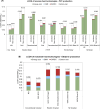Technical, Environmental, and Economic Analysis Comparing Low-Carbon Industrial Process Heat Options in U.S. Poly(vinyl chloride) and Ethylene Manufacturing Facilities
- PMID: 38446013
- PMCID: PMC10956540
- DOI: 10.1021/acs.est.3c05880
Technical, Environmental, and Economic Analysis Comparing Low-Carbon Industrial Process Heat Options in U.S. Poly(vinyl chloride) and Ethylene Manufacturing Facilities
Abstract
Electrification and clean hydrogen are promising low-carbon options for decarbonizing industrial process heat, which is an essential target for reducing sector-wide emissions. However, industrial processes with heat demand vary significantly across industries in terms of temperature requirements, capacities, and equipment, making it challenging to determine applications for low-carbon technologies that are technically and economically feasible. In this analysis, we develop a framework for evaluating life cycle emissions, water use, and cost impacts of electric and clean hydrogen process heat technologies and apply it in several case studies for plastics and petrochemical manufacturing industries in the United States. Our results show that industrial heat pumps could reduce emissions by 12-17% in a typical poly(vinyl chloride) (PVC) facility in certain locations currently, compared to conventional natural gas combustion, and that other electric technologies in PVC and ethylene production could reduce emissions by nearly 90% with a sufficiently decarbonized electric grid. Life cycle water use increases significantly in all low-carbon technology cases. The levelized cost of heat of viable low-carbon technologies ranges from 15 to 100% higher than conventional heating systems, primarily due to energy costs. We discuss results in the context of relevant policies that could be useful to manufacturing facilities and policymakers for aiding the transition to low-carbon process heat technologies.
Keywords: decarbonization; electrification; hydrogen; industrial process heat; levelized cost of heat; techno-economic analysis.
Conflict of interest statement
The authors declare no competing financial interest.
Figures






Similar articles
-
The Minderoo-Monaco Commission on Plastics and Human Health.Ann Glob Health. 2023 Mar 21;89(1):23. doi: 10.5334/aogh.4056. eCollection 2023. Ann Glob Health. 2023. PMID: 36969097 Free PMC article. Review.
-
Planning Implications Related to Sterilization-Sensitive Science Investigations Associated with Mars Sample Return (MSR).Astrobiology. 2022 Jun;22(S1):S112-S164. doi: 10.1089/AST.2021.0113. Epub 2022 May 19. Astrobiology. 2022. PMID: 34904892
-
The Role of Hydrogen in Decarbonizing U.S. Iron and Steel Production.Environ Sci Technol. 2025 Mar 18;59(10):4915-4925. doi: 10.1021/acs.est.4c05756. Epub 2025 Mar 6. Environ Sci Technol. 2025. PMID: 40047340 Free PMC article.
-
Electrification of Transit Buses in the United States Reduces Greenhouse Gas Emissions.Environ Sci Technol. 2024 Mar 5;58(9):4137-4144. doi: 10.1021/acs.est.2c07296. Epub 2024 Feb 19. Environ Sci Technol. 2024. PMID: 38373231 Free PMC article.
-
Environmental management of industrial decarbonization with focus on chemical sectors: A review.J Environ Manage. 2022 Jan 15;302(Pt B):114055. doi: 10.1016/j.jenvman.2021.114055. Epub 2021 Nov 10. J Environ Manage. 2022. PMID: 34768037 Review.
References
-
-
CO2 Emissions in 2022, 2023. [Online]. Available:
-
-
-
Industry: Tracking Report, 2022. [Online]. Available:
-
-
-
Climate Change 2023: Synthesis Report. Summary For Policymakers, 2023. [Online]. Available:
-
-
-
Inventory of U.S. Greenhouse Gas Emissions and Sinks: 1990–2021, Reports and Assessments, 2023. [Online]. Available:
-
-
-
Energy Technology Perspectives 2020, 2020. [Online]. Available:
-
MeSH terms
Substances
LinkOut - more resources
Full Text Sources

